
WHAT IS AKSHARDHAM
SPIRITUAL SIGNIFICANCE
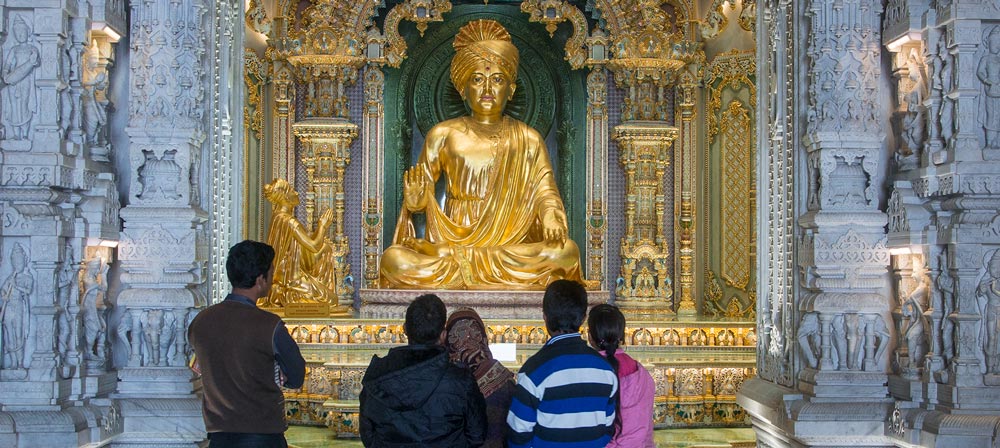
Each element of Akshardham echoes with spirituality – the Mandir, the Exhibitions and even the Gardens.
The Akshardham mandir has over two hundred murtis, representing many of the spiritual stalwarts over many millennia. The spiritual premise of Akshardham is that each soul is potentially divine. Whether we are serving the family, the country our neighbors or all living beings the world over , each service can help one move towards divinity. Each prayer is a call towards improving oneself and moving closer to God.
A visit to Akshardham is a spiritually enriching experience. Whether it is in realising the power of prayer, in feeling the strength of non-violence, in being aware of the universal nature of Hinduism’s ancient principles, or just in admiring the beauty of God’s abode on Earth –- each element has a spiritual significance.
The Akshardham mandir has over two hundred murtis, representing many of the spiritual stalwarts over many millennia. The spiritual premise of Akshardham is that each soul is potentially divine. Whether we are serving the family, the country our neighbors or all living beings the world over , each service can help one move towards divinity. Each prayer is a call towards improving oneself and moving closer to God.
A visit to Akshardham is a spiritually enriching experience. Whether it is in realising the power of prayer, in feeling the strength of non-violence, in being aware of the universal nature of Hinduism’s ancient principles, or just in admiring the beauty of God’s abode on Earth –- each element has a spiritual significance.
FACTS AND FIGURES
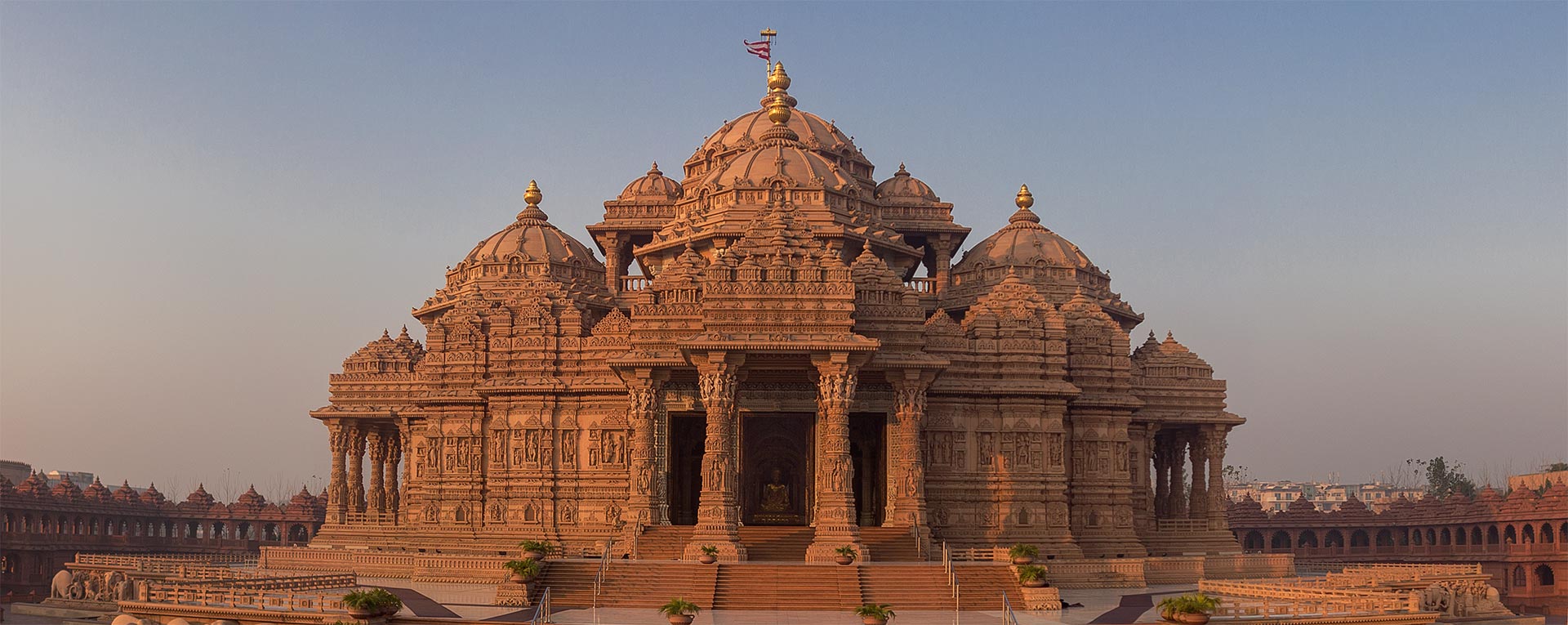
- Opened 6th November 2005
- Constructed by Bochasanwasi Shri Akshar Purushottam Swaminarayan Sanstha (BAPS)
- Inspired by HH Yogiji Maharaj (1892-1971 CE)
- Created by His Holiness Pramukh Swami Maharaj
- More than 300,000,000 volunteer hours went into making the complex
- Over 8,000 volunteers from across the world participated in building it
- Mandir built from intricately carved sandstone and marble
- Exhibitions on Hinduism, including Bhagwan Swaminarayan's life and teachings such as prayer, compassion, and non-violence.
- Open gardens, water bodies and step-well styled courminutes
- SWAGATAM – THE WELCOME

A pilgrimage at Akshardham begins at the Ten Gates – signifying ten directions – and continues as visitors pass through the Gate of Devotion, the Visitor Center and the Peacock Gate to arrive at the Charnarvind. Along the way, traditional Hindu symbols of positivity, devotion, beauty and purity create a divine ambience. Each visitor delves into the experience of Akshardham infused with the energy of this auspicious beginning.

WELCOME GATES
आ नो भद्राः क्रतवो यन्तु विश्वतः
“Let noble thoughts come to us from all directions.” - Rig Veda
The ten gates symbolize the ten directions described in Indian culture. They reflect the sentiments of accepting all that is auspicious and good from every direction. Such openness of mind and heart fosters the spirit of universal love, brotherhood and peace in the world.
“Let noble thoughts come to us from all directions.” - Rig Veda
The ten gates symbolize the ten directions described in Indian culture. They reflect the sentiments of accepting all that is auspicious and good from every direction. Such openness of mind and heart fosters the spirit of universal love, brotherhood and peace in the world.

BHAKTI DWAR
This ornate stone entrance symbolizes the offering of pristine bhakti – devotion – towards the dual forms of God and his devotee (Bhakta-Bhagwan). Devout Hindus offer their bhakti to Akshar-Purushottam, Lakshmi-Narayan, Sita-Ram, Radha-Krishna, Parvati-Shiv, Nar-Narayan and others.
The Bhakti Dwar has 208 beautifully carved pairs of Bhakta-Bhagwan bestowing their blessings on all.
The Bhakti Dwar has 208 beautifully carved pairs of Bhakta-Bhagwan bestowing their blessings on all.

VISITOR CENTER
Through the Bhakti Dwar or Gate of Devotion, one enters Akshardham's Visitor Center. The Visitor Center greets everyone with a display of bells to welcome all that is good. In the Visitor Center, one will find volunteers ready to assist in planning one's time at the Akshardham complex. Informative posters help introduce the complex and its different components.

MAYUR DWAR
The peacock stands for beauty and self-control in Indian culture. It is the national bird of India and loved by people across the country. It is revered by virtue of its association with divine incarnations and stories in the Hindu shastras. Each of the two Mayur Dwars has 869 intricately carved stone peacocks welcoming visitors with their enchanting beauty and poise.
CHARNARVIND (HOLY FOOTPRINTS)

A large marble replica of the holy footprints, or 'charanarvind', of Bhagwan Swaminarayan (1781-1830 CE) between the two Mayur Dwars commemorate his incarnation on Earth. The sixteen holy symbols which mark God’s feet as per the Hindu shastras are seen in these holy footprints. In humble reverence to Bhagwan Swaminarayan, four conch shells shower water at his lotus feet.
MANDIR
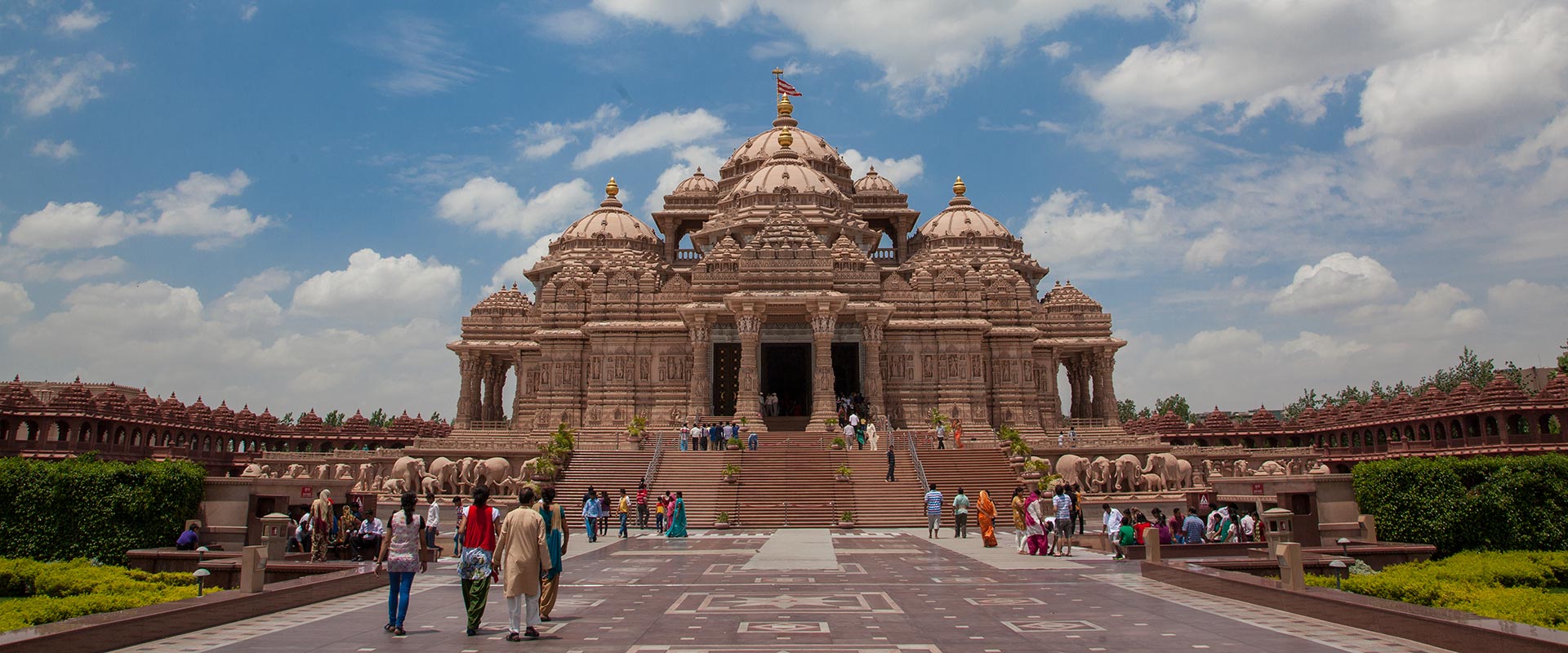
The heart of the Swaminarayan Akshardham complex is the Akshardham mandir.
Inaugurated on 6 November 2005, the mandir is an effort to offer a home to God that honors . His glory and divinity –- a timeless, beautiful and peaceful home for God here on Earth. It is a temporal abode of God and the devotion, values and culture He inspires.
Architecturally, the mandir is an homage to traditional Indian Hindu architecture. It is designed with an eye to The ancient and middle-agemedieval Indian treatises on architectural science, - the shilpa shastras, have guided the mandir’s design and construction from its distinctive style of carving and its proportions to its avoidance of .
Accordingly, the mandir is made without the use of ferrous metal in construction.
The Akshardham mandir consists of 234 intricately carved pillars, 9 ornate domes, 20 quadrangled spires and 20,000 statues of India’s Hinduism’s spiritual personalities. The mandir reaches 141.3 feet into the sky, spans 316 feet in width,
and is 356 feet long.
Inside the mandir, each worshipfully carved pillar, ceiling and dome shares a story of devotion, offers darshan of a deity, or captures an incident from the life of Bhagwan Swaminarayan.
Inaugurated on 6 November 2005, the mandir is an effort to offer a home to God that honors . His glory and divinity –- a timeless, beautiful and peaceful home for God here on Earth. It is a temporal abode of God and the devotion, values and culture He inspires.
Architecturally, the mandir is an homage to traditional Indian Hindu architecture. It is designed with an eye to The ancient and middle-agemedieval Indian treatises on architectural science, - the shilpa shastras, have guided the mandir’s design and construction from its distinctive style of carving and its proportions to its avoidance of .
Accordingly, the mandir is made without the use of ferrous metal in construction.
The Akshardham mandir consists of 234 intricately carved pillars, 9 ornate domes, 20 quadrangled spires and 20,000 statues of India’s Hinduism’s spiritual personalities. The mandir reaches 141.3 feet into the sky, spans 316 feet in width,
and is 356 feet long.
Inside the mandir, each worshipfully carved pillar, ceiling and dome shares a story of devotion, offers darshan of a deity, or captures an incident from the life of Bhagwan Swaminarayan.
GARBHAGRUH
The inner sanctum or garbhagruh of the Akshardham mandir is home to Bhagwan Swaminarayan and his divine succession of gurus - Gunatitanand Swami, Bhagatji Maharaj, Shastriji Maharaj, Yogiji Maharaj, and Pramukh Swami Maharaj.
As manifestations of Aksharbrahma, the gurus, as manifestations of Aksharbrahma, are God’s eternal servants and ideals of saintliness and devotion.
They reside in the garbhagruh eternally offering service and worship to Bhagwan Swaminarayan. Items sanctified by Bhagwan Swaminarayan during his time on Earth are also preserved for darshan directly behind the garbhagruh.
Around the garbhagruh, special altars are devoted to other Hindu deities of Sanatana Dharma: Shri Sita-Ram, Shri Radha-Krishna, Shri Lakshmi-Narayan, and Shri Shiv-Parvati.
Learn More »
As manifestations of Aksharbrahma, the gurus, as manifestations of Aksharbrahma, are God’s eternal servants and ideals of saintliness and devotion.
They reside in the garbhagruh eternally offering service and worship to Bhagwan Swaminarayan. Items sanctified by Bhagwan Swaminarayan during his time on Earth are also preserved for darshan directly behind the garbhagruh.
Around the garbhagruh, special altars are devoted to other Hindu deities of Sanatana Dharma: Shri Sita-Ram, Shri Radha-Krishna, Shri Lakshmi-Narayan, and Shri Shiv-Parvati.
Learn More »
MANDAPAMS
The interior of the Akshardham mandir can be divided into nine mandapams or thematic spaces. These nine mandapams are each filled with intricately carved murtis and pillars and capped by unique domes and ceilings. Travelling through these mandapams, one meets renowned devotees, great avatars and rejoicing celestial beings. The ornate designs and intricate carvings of the mandapams inspire reflection of God’s inconceivable beauty and the beauty he inspires in creation.
Learn More »
Learn More »
MANDOVAR

The external facade of a traditional stone temple is known as a mandovar. Swaminarayan Akshardham's mandovar is the largest, most intricately carved mandovar built in India in the last eight hundred years. It is 25 feet high, 611 feet long and features 200 sculptured stone figures of many of Hinduism’s great rishis, sadhus, devotees, acharyas and avatars.
The base of the mandovar is called the jagati. In this layer, one finds carvings of living beings from our everyday world. First, we have the elephant which is a symbol of strength, then the lion, which symbolizes bravery and ferocity. Thereafter, one finds the vyal (a Pauranic animal) that was renowned for speed.
In the subsequent layers, one finds carvings of flowers that stand for beauty and fragrance. In the middle of the mandovar, known as vibhuti, are sculptures of the avatars, sages, devas, acharyas and devotees.
And on top within this layer are the samarans that exhort people to strive for spiritual height in life. The entire mandovar inspires an individual to liberate his life from the shackles of mundane pleasures and ascend to the ultimate state of God-realization.
The base of the mandovar is called the jagati. In this layer, one finds carvings of living beings from our everyday world. First, we have the elephant which is a symbol of strength, then the lion, which symbolizes bravery and ferocity. Thereafter, one finds the vyal (a Pauranic animal) that was renowned for speed.
In the subsequent layers, one finds carvings of flowers that stand for beauty and fragrance. In the middle of the mandovar, known as vibhuti, are sculptures of the avatars, sages, devas, acharyas and devotees.
And on top within this layer are the samarans that exhort people to strive for spiritual height in life. The entire mandovar inspires an individual to liberate his life from the shackles of mundane pleasures and ascend to the ultimate state of God-realization.
NARAYAN PEETH

It is an ancient Hindu tradition to perform pradakshinas or circumambulations as a sign of respect and prayers. The faithful walk clockwise around mandirs to reinforce the belief that God should be the center of one’s life.
At the Akshardham mandir, the path for performing these circumambulations is embellished with three 60 feet long bronze relief panels. These panels illustrate divine incidents from the life of Bhagwan Swaminarayan and help the faithful walking these paths to remember God as they perform circumambulations. The layer of the mandir where these panels are installed is known as the Narayan Peeth.
At the Akshardham mandir, the path for performing these circumambulations is embellished with three 60 feet long bronze relief panels. These panels illustrate divine incidents from the life of Bhagwan Swaminarayan and help the faithful walking these paths to remember God as they perform circumambulations. The layer of the mandir where these panels are installed is known as the Narayan Peeth.
GAJENDRA PEETH
A mandir stands, traditionally and symbolically, on the shoulders of elephants. In a uniquely creative adaptation, the elephants at the base of Swaminarayan Akshardham are not just standing still. The Gajendra Peeth or Elephant Plinth presents stories and legends of elephants with nature, with humans and with God. This depiction of elephants is to honor these grand yet gentle animals and also share messages of peace, beauty and gentleness. Learn More »
ENTRY AND TIMINGS
Entry: Free and open to all.

Timings:
9:30am to 8:00pm.
Aarti:
10:00am and 6:00pm.
Time to See: 45 minutes
Note:



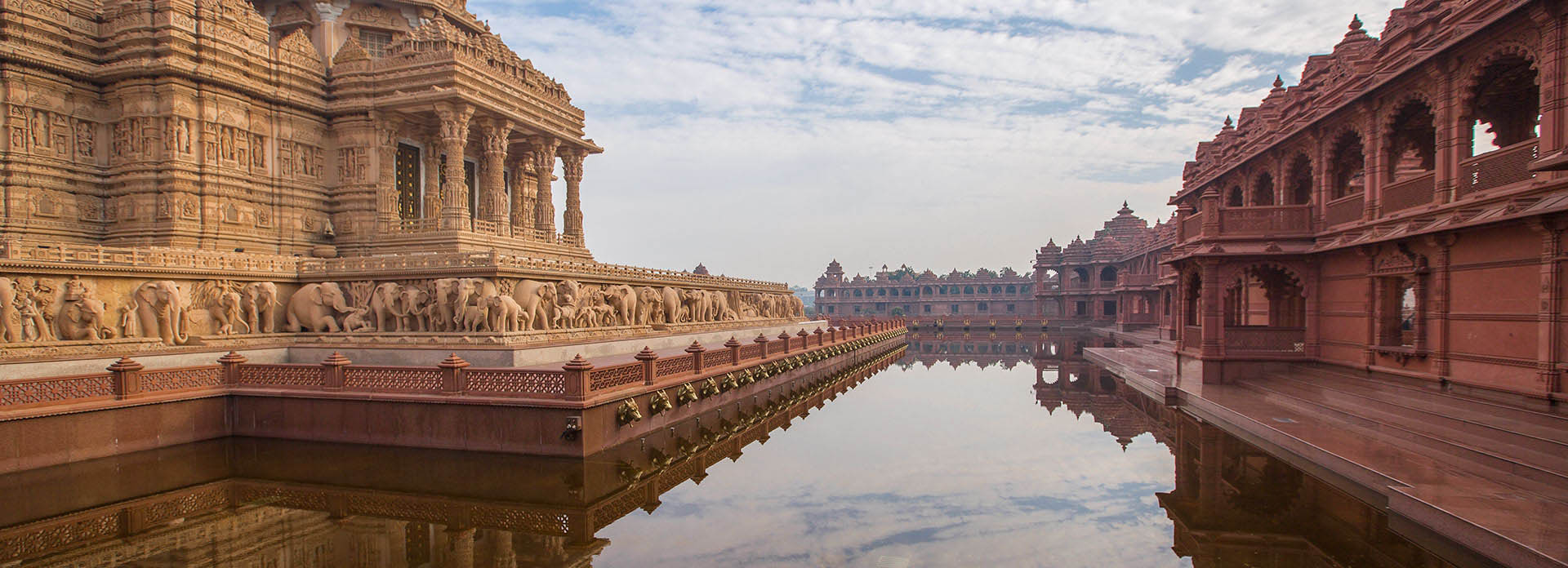


- Shoes are not allowed in Mandir. Please deposit them in the shoe-house located in front of the mandir. Please collect your shoes back before you visit the Gajendra Peeth.
- Gajendra Peeth provides ample space for wheelchair movement. The Mandir and Narayan Peeth are not wheelchair-accessible.
ABHISHEK MANDAP

Abhishek is the ritual bathing of a deity for the fulfilment of one’s prayers. The worshiper pours water over the deity amidst the chanting of prayers and mantras.
ABHISHEK OF NEELKANTH

Visitors can perform abhishek of the murti of Neelkanth Varni - the youthful, yogic form of Bhagwan Swaminarayan. This ritual bathing of the murti is a uniquely participatory ritual, open to all visitors.
An abhishek is most commonly accompanied by prayers for wish fulfilment.
Pramukh Swami Maharaj, spiritual leader of the BAPS Swaminarayan fellowship,
consecrated this murti of Neelkanth Varni in 2005.
An abhishek is most commonly accompanied by prayers for wish fulfilment.
Pramukh Swami Maharaj, spiritual leader of the BAPS Swaminarayan fellowship,
consecrated this murti of Neelkanth Varni in 2005.
ABHISHEK RITUAL

The abhishek ritual begins with the tying of a sacred thread on the wrist. A brief recital of sanskrit shlokas follows, after which each visitor or family bathes the murti of Neelkanth Varni with a small pot of sanctified water. During the shlokas and the bathing, visitors are encouraged to pray for their families, friends, themselves and for harmony and happiness for all.
NARAYAN SAROVAR

Since Vedic times, India has a glorious tradition of respecting rivers, lakes and stepwells. Following this tradition, a sacred water body, Narayan Sarovar, surrounds the main Akshardham mandir. Narayan Sarovar contains the holy waters of 151 rivers and lakes sanctified by Bhagwan Swaminarayan, including Manasarovar, Pushkar Sarovar, Pampa Sarovar, Indradyumna Sarovar, Manikarnika Ghat, Prayag Triveni Sangam, River Kshipra, Rivers Ganga and Yamuna and many others.
On the outer wall of the mandir are 108 bronze gaumukhs, symbolizing 108 names of God, from which holy water spouts forth.
On the outer wall of the mandir are 108 bronze gaumukhs, symbolizing 108 names of God, from which holy water spouts forth.
TICKETS AND TIMINGS
Abhishek Donation:
₹ 50 per person.

Timings: 9:30am to 8:00pm.
Aarti Time: 6:30pm.
Time to See:
10 to 25 minutes
Ritual Duration:
10 to 15 minutes
Note: Deposit your shoes in a shoe-rack outside the Abhishek Mandap. Please wash your hands before entering and maintain silence during Abhishek.
ENTRY AND TIMINGS
Entry: Free and open to all.

Timings:
9:30am - 6:30pm
Time to See:
30 minutes


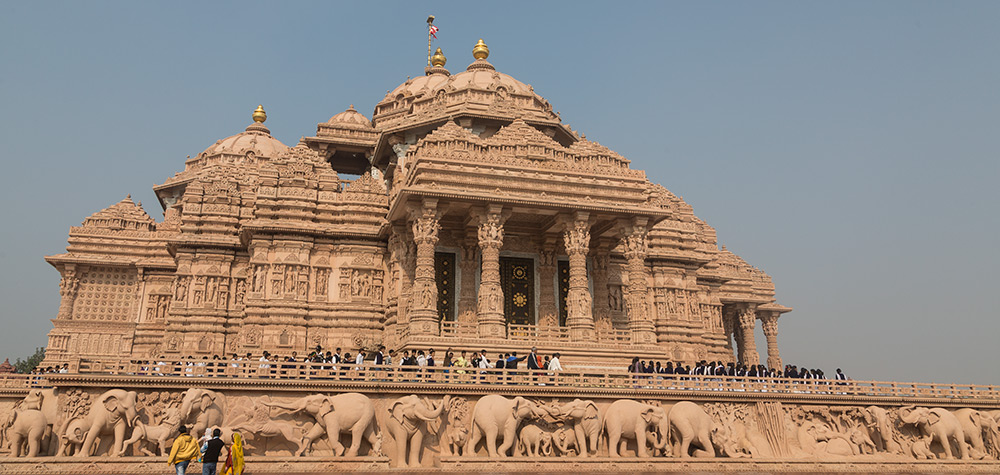
No comments:
Post a Comment